How does river water get potable?

Open the tap and pour water into the kettle - what could be easier? Take the river water, clean it to the state of drinking, and then turn the dirty sewage back into clean water - what could be more difficult? And more expensive. We understand how water from rivers flows into our faucet and how much we have to pay for cleaning it.
Main sources of fresh water
71% of our planet is covered with water. Basically, salt water, absolutely unsuitable for drinking. In the total amount of world water only 3% is fresh . If 68% of ice at the poles and 30% of underground freshwater sources are removed from this modest volume, 0.8% will remain in permafrost, 0.2% in lakes, 0.006% in rivers and a little more in the atmosphere. That is, the amount of readily available fresh water on the planet is small, and the one that is, most often not suitable for drinking without treatment. So let us take as a starting point the fact that drinking water is an expensive and scarce resource.
Russia leads in the amount of surface fresh water, so most often water for urban water supply is taken from large lakes and rivers. For small settlements artesian wells are used. But even in those areas where relatively clean rivers flow or wells are dug, water requires preparation before it can be used for central water supply, as there may be viruses, dangerous bacteria, heavy metals and other chemical contaminants in the water. So glandular water hits the liver and the cardiovascular system, excess fluoride spoils teeth and bones, dioxins left over from burning garbage harm the nervous system and cause cancer, too hard water provokes the formation of kidney stones, and lead negatively affects the development of children and causes anemia. And about bacteria and viruses, everything is clear - diseases, Allergies and disorders of the gastrointestinal tract are provided. And it would also be good to clean the used water, and not just to drain it back into the river.
The urban water treatment cycle consists of two stages: water withdrawal from reservoirs and purification for use in water mains, and then purification of the resulting sewage and discharge of water back into water reservoirs. That is, water supply and sewage.
Water purification for plumbing
First, with the example of Moscow, let’s see how water gets into the water supply system. According to the Mosvodokanal website, “the centralized water supply in the Moscow region is mainly from surface water sources. They are the Moskvoretsko-Vazuzskaya and Volga water systems, which include 15 reservoirs and water supply paths - the Moskva River with tributaries and a canal to them. Moscow. ”The total daily water yield of the capital’s water intake stations is 11 million cubic meters, which is almost four times higher than consumption.
Muscovites drink water from the Moscow River that flows through the whole city, although this idea is scary at first. In fact, before the contents of the navigable rivers get into the apartments, the water undergoes a comprehensive cleaning at one of the four water treatment plants. Places of water intake from rivers are closed and carefully guarded - these are literally strategic facilities.
After coarse filtration, the water is ozonated, eliminating organics of all sizes, and mixed with coagulants and flocculants. These reagents "knock down" the remaining contaminants in the flakes, which then settle. Mixing water with reagents occurs within ten minutes - with less time, flakes are not formed, with longer mixing time they begin to break down. After sedimentation, the water is again ozonated and sent to filter.
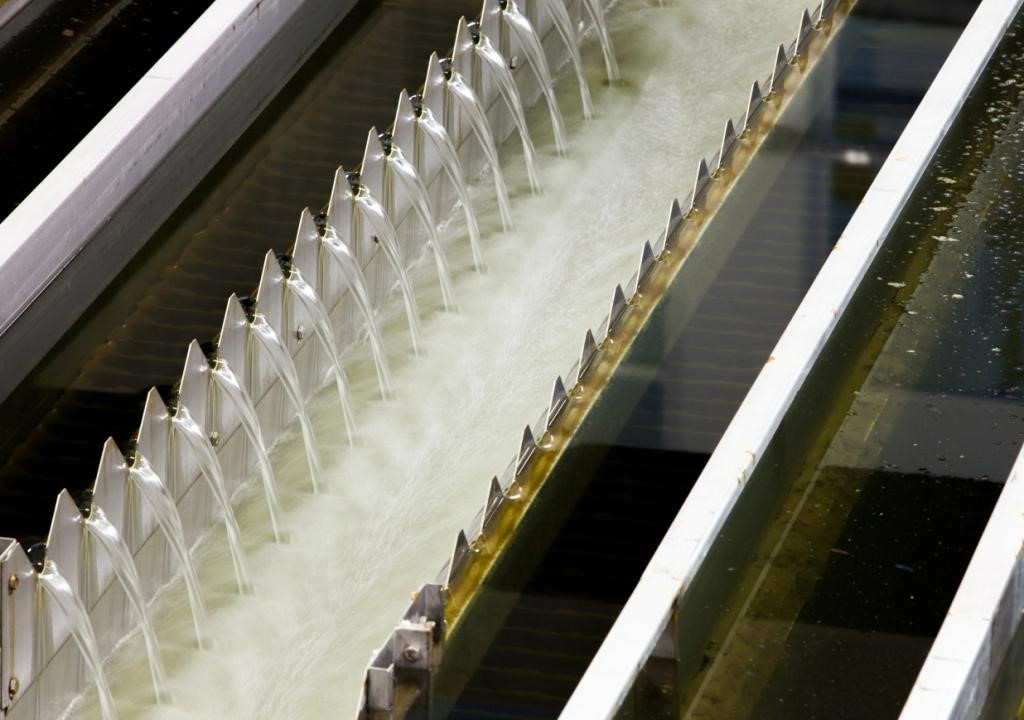
Thin trickles of water after settling flakes. Source: Mosvodokanal
The filter is a two-meter layer of sand, through which water passes naturally. Such a filter is cleaned about once a day with clean water from the reverse side. Then water is poured into another tank, where it also passes under a one-and-a-half meter layer of charcoal under its own weight.
The final stage of purification are membranes capable of trapping particles as small as 0.01 microns in size (this is not a typo). Every hour the membranes are cleaned with a reverse flow of water. From this point on, water is considered to be drinking, that is, completely safe for health. Water analysis at all stages is performed every four hours, and in high-risk conditions (for example, spring flood) once an hour.

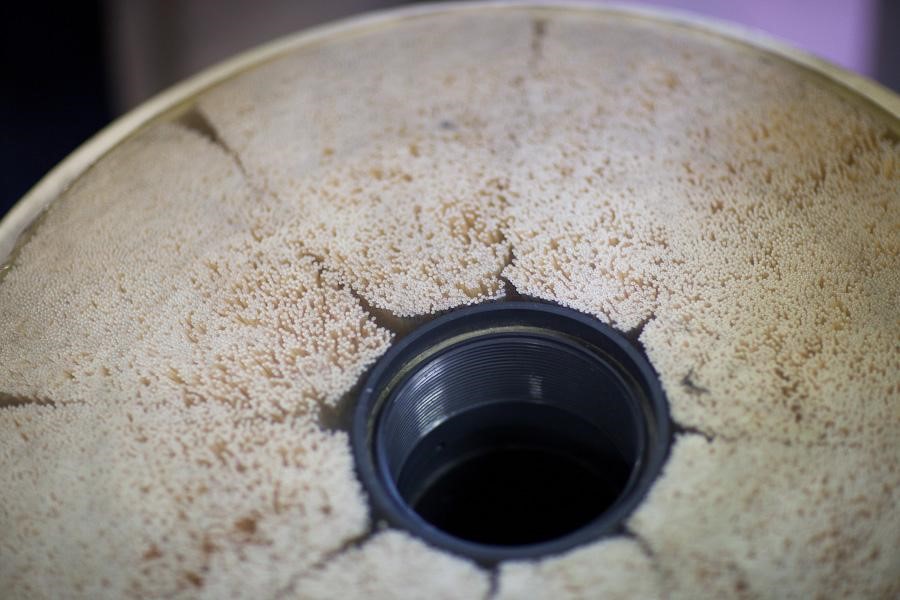
Membrane modules and their contents. Source: Mosvodokanal.
By the way, water is not cleaned with chlorine - it, or rather safe sodium hypochlorite, is added at the very end to prevent water contamination while passing through urban pipelines. At least in Moscow, cold tap water is officially considered completely safe for drinking without additional purification and boiling.
Sewage treatment
It is not easy to turn river water into drinking water, but it is even more difficult to clean sewer drainage to a state of clean and environmentally safe water. The capital is served by four water treatment plants, where wastewater from sewers flows. The largest and most modern of them, Kuryanovskaya, is capable of processing up to 3.1 million cubic meters per day after modernization . Lyubertsy facilities, if necessary, will take another 3 million cubic meters, Zelenograd and Butovskiye together - 220 thousand cubic meters. That is, the capacity of the sewage treatment plant, which turns Moscow's sewage into clean, safe water, is twice the current consumption of the city.
They work like that. First, through pipes, the effluent enters the receiving chamber of the sewage treatment plant - these are large tanks, which until recently were open, from which an unbearable smell spread to kilometers around. Fortunately, the Moscow wastewater treatment plant was covered with special covers, so the residents of the surrounding houses were finally able to forget about the smell of sewage.
Unbearably dirty water with a huge amount of garbage discharged into the sewage system undergoes a rough mechanical cleaning, during which all foreign objects that are visible to the eye are removed. The dry residue is pressed and transported to storage sites.
Further, in the septic tanks, part of the mud settles naturally, after which the water, still dirty and foul-smelling, can be sent for aeration. During this process, in aeration tanks (this is not a typo!), Water is mixed with special sludge and bacteria, which “eat up” most of the pollution and organic matter.
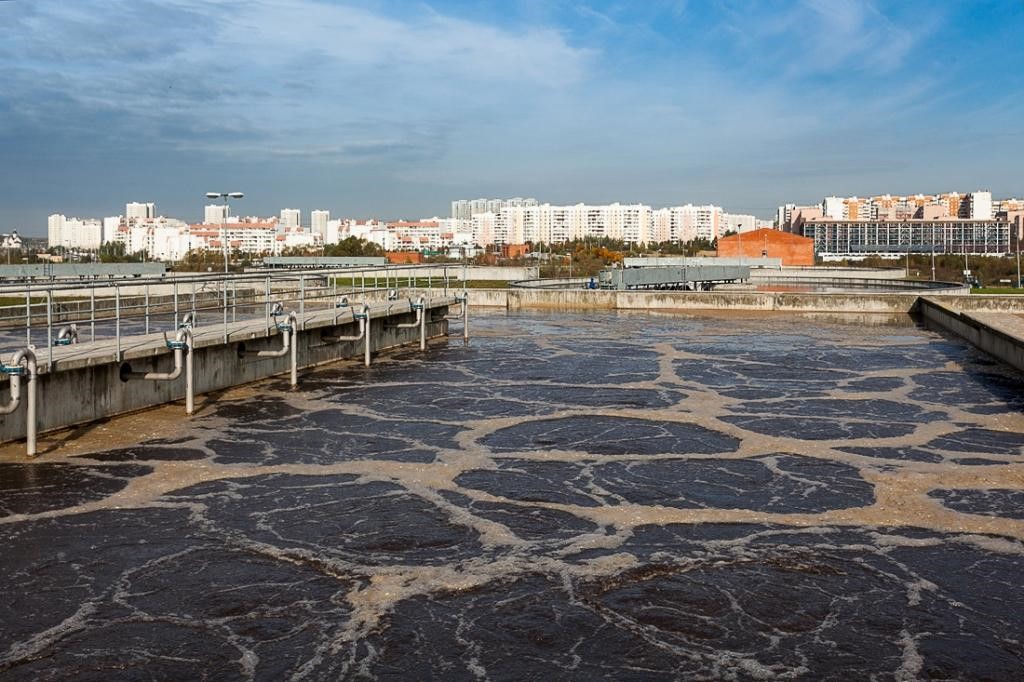
In warm water saturated with oxygen, bacteria purify water faster. Source: Mosvodokanal The
settling sludge is slowly removed by sludge. You, probably, met photos of treatment facilities, where in the round pools a bridge was built from the center to the edge. This is the ilosos, which slowly rotates, like a clock hand, and collects silt from the bottom. By the end of the work of ilososa, the water becomes clear, clean, but not yet safe.

The septic tanks with ilosos are the most recognizable part of the treatment plant. Source: Mosvodokanal
At the last stage, the water at the Moscow wastewater treatment plant is disinfected with powerful quartz lamps and then discharged into the river. Formally, the former sewage runoff is cleaner than water taken from the river for primary treatment for water supply. By the way, neither chlorine nor ozonization of sewage water can be, otherwise residual traces of gas and chemicals will fall into the river and, together with bacteria, will destroy all living things.
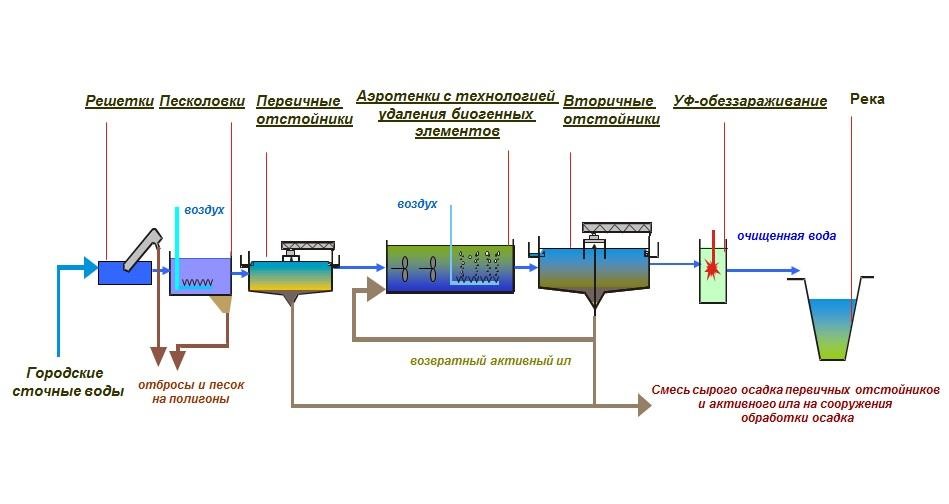
Visual scheme of modern cleaning from Mosvodokanal. Source: Mosvodokanal
Pocket water purifier
The idea of a portable tool for cleaning any water to the level of drinking was always relevant. During the First World War, soldiers made sand, gravel, and brick filters; tablets with chlorine and a dechlorinating agent were intended for individual use. Now in the Russian military IRP put tablets for water disinfection with sodium salt of dichloroisocyanuric acid.

This is not a publicity stunt - the LifeStraw portable filter really lets you drink water from any source. Well, or almost any ... Source: Vestergaard
In 2008, the LifeStraw tubular filter from the Swiss company Vestergaard became a real breakthrough, through which you can drink water from virtually any body of water, even from a puddle. The distinction of LifeStraw from typical carbon filters was the use of a 0.2 micron tubular membrane, which coped with bacteria and parasites better than coal. Early versions of LifeStraw did not protect against heavy metals and viruses, but the updated LifeStraw Flex was able to filter them. Different versions of LifeStraw have a resource from 1800 to 4000 liters and cost from $ 19.95.

A bundle of thin tubes - this is the LifeStraw membrane filtering system. Just the same, as on membrane filters of the Moscow treatment facilities. Source: YouTube
Now on sale you can find a lot of tourist bottles and tubes with filters, however, you should pay attention to the filter element. If only coal is mentioned in the description, you should not risk picking up water from puddles and standing bodies of water - limit yourself to tap water. Coal deodorizes water, removes heavy metals and chlorine, but allows viruses and bacteria to pass through.
How much does water purification cost?
Scientific and technical magic to transform millions of tons of waste into water sounds great, but how much does such a complex process cost? In the open budget of Moscow, about 900 million rubles a year were allocated for the collection, disposal of waste and wastewater treatment, and this is only the maintenance of the existing infrastructure. And the cost of upgrading and building new facilities can amount to billions.
This is despite the fact that the measures of efficient use and economy have reduced the waste of water even in Moscow, although the population of the capital has grown by a third over 20 years. According to the data of the same Mosvodokanal, in 2018 Muscovites spent about 3 million cubic meters of water. If in 1995 every resident of the city poured into the sewer about 450 liters per day, now there are about 202 liters.
Also important is the fact that a lot of money during water purification is spent on energy supply. In the US, for example, this is 4% of all electricity consumed .
Is it cheaper?
If water supply enterprises do not have cheap and environmentally friendly (rare combination) energy sources, then they will have to do with what they have, that is, to use local energy companies and pay them at the established tariffs. Some savings in the future can be provided by upgrading station equipment, but this requires serious investments. One way remains: to increase the energy efficiency, without reducing the quality of cleaning.
For Japan, the energy consumption of water purification also became a problem - it takes 0.7% of the country's electricity, and electricity on the island is much more expensive than Russian. Yukio Hiraoka, Chief Specialist, Water & Environmental Systems at Toshiba Infrastructure Systems & Solutions Corporation, proposed the ideadynamic changes in air flow for aeration of water during the day. Aeration, which is necessary for the vital activity of bacteria, accounts for up to 60% of the electricity of sewage treatment plants, however, the flow of sewers varies depending on the time of day - in the morning and evening hours more, at night there are almost no new drains, excessive aeration of already purified water will not do anything. So, instead of constant aeration at the same power, you can change the air supply, while maintaining the effectiveness of water purification.
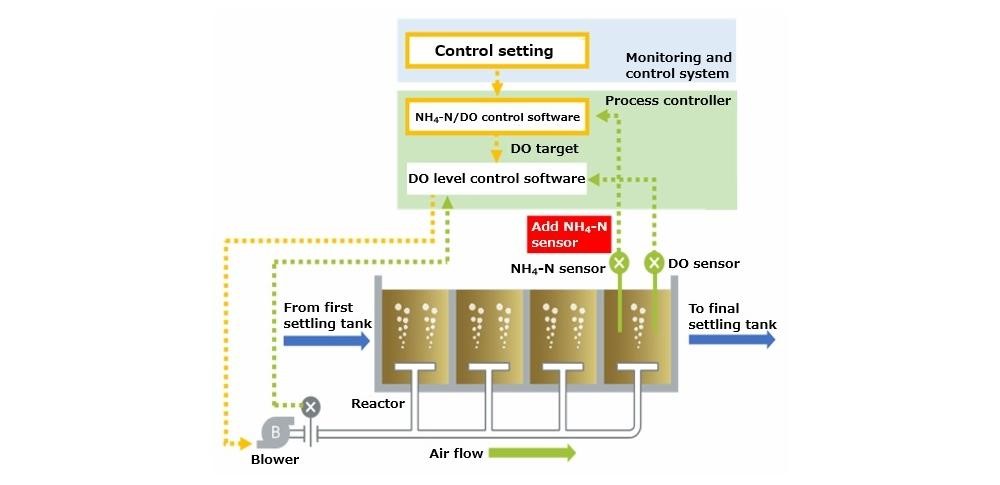
Toshiba add-on aeration system. Source: Toshiba
To determine the quality of water, the marker NH4-N is used, the amount of which indicates that the effluent is ready for further treatment. Based on this fact, Toshiba has created a sensor that tests the NH4-N concentration and the amount of oxygen dissolved in the water. Special software reads the sensor and, if necessary, “tightens the valve”, stopping the senseless excessive aeration.
The development of Toshiba reduced the air flow by 10.3%, which made it possible to recoup it a little more than in two years and subsequently reduce the cost of water purification by reducing the consumption of electricity by air pumps. Toshiba's solution does not require re-equipment of sewage treatment plants - this is just a sensor, a computer and software, but if the solution is applied across a whole country, for example, Russia, the savings on water purification will amount to billions of rubles.
